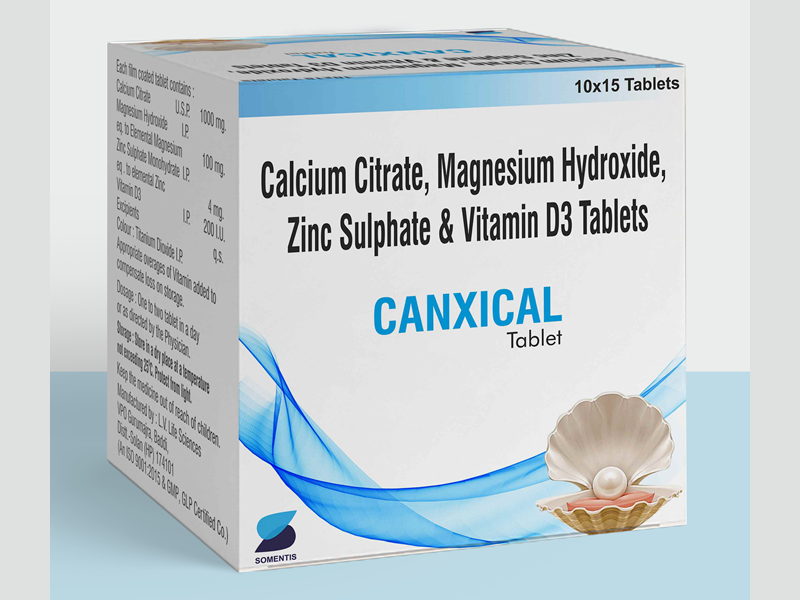Canxical
Calcium Citrate, Magnesium Hydroxide, Zinc Sulphate & Vitamin D3 Tablets
Calcium Citrate
AS A DIETARY ITEM HELPS IN BONE MINERALIZATION. Calcium is the fifth most abundant element in the body. Calcium is a divalent metal essential for the maintenance of the nervous, muscular, and skeletal systems, and for cell membrane and capillary permeability. Its role in bone structure and muscle contraction is well known, but calcium is also important for blood coagulation, nerve conduction, and electrical conduction in the heart.
Dose
250-500 MG OD/BD
Monograph
Calcium Citrate
Calcium is a cation administered as various calcium-contain-
ing salts. Calcium salts have been reported to be incompati-
ble with a wide range of drugs. Complexes may form
resulting in the formation of a precipitate.
Calcium Citrate
A white, odourless, crystalline powder. Each g of calcium ci-
trate (tetrahydrate) represents approximately 5.3 mmol of cal-
cium and 3.5 mmol of citrate. Calcium citrate (tetrahydrate)
4,74 g is approximately equivalent to I g of calcium,
Slightly soluble in water: practically insoluble in alcohol:
freely soluble in diluted 3N hydrochloric acid and in diluted
2N nitric acid.
The pharmacological properties are same as calcium chloride , so click to cal chloride for details.
Magnesium Hydroxide
Monograph
Magnesium Hydroxide
A fine white amorphous powder. Practically insoluble in wa-
ter and alcohol; dissolves in dilute acids. A solution in water
is alkaline to phenolphthalein. Store in airtight containers.
Adverse Effects, Treatment, and Precautions
Magnesium hydroxide, in common with other mag-
nesium salts , may cause diarrhoea. Hy-
permagnesaemia may occur in patients with
impaired renal function.
There have been reports of hypermagnesaemia in
infants given magnesium-containing antacids."
Interactions
Antacids, including magnesium salts, interact with many other
drugs both by alterations in gastric pH and emptying, and by
formation of complexes that are not absorbed. Inter-
actions can be minimised by giving the antacid and
any other medications 2 to 3 hours apart.
Uses and Administration
Magnesium hydroxide is an antacid
that is given in doses of up to about I g by mouth. It
is often given in conjunction with aluminium-con-
taining antacids such as aluminium hydroxide
which counteract its laxative effect.
Magnesium hydroxide is also given as a laxative in
doses of up to about 5 g by mouth and as a magne-
sium supplement in deficiency states.
Magnesium hydroxide is also used as a food addi-tive.
Renal calculi. Magnesium salts' have been used in the
prophylaxis of recurrent renal calculi .
Zinc Sulphate
ZINC IS AN ESSENTIAL ELEMENT OF NUTRITION. IT PLAYS AN IMPORTANT ROLE IN VARIOUS BIOLOGICAL ACTIVITIES PARTICULARLY IN NUMEROUS ENZYMATIC PATHWAYS INCLUDING SYNTHESIS OF NUCLEIC ACIDS AND METABOLISM OF PROTEINS, CARBOHYDRATES AND LIPIDS. IT ALSO HELPS IN THE DEVELOPMENT OF CELL MEDIATED IMMUNITY.
Dose:
THE USUAL DOSE :- 50 MG THREE TIMES DAILY. WHEN I.V SUPPLIMENTS ARE REQUIRED, ZINC CHLORIDE OR ZINC SULPHATE MAY BE GIVEN, SUGGESTED DOSE- 6.5 MG OF ELEMENTAL ZINC (100 MICRO MOL) DAILY.
Monograph
Zinc sulphate
The properties are same as zinc, so click to zinc for the details.

